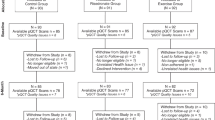Abstract
The aim of this study was to evaluate Singh index as a simple and inexpensive means of estimation of bone quality in patients with rheumatoid arthritis. Singh index evaluation was made on digital pelvis radiographs in 50 consecutive patients by three observers. Bone mineral density T scores of the spine and left proximal femur were assessed using dual energy X-ray absorptiometry. Singh index was correlated with densitometry measurements after grouping the patients as normal, osteopenia and osteoporosis. Intra- and interobserver agreements were evaluated by kappa correlations. Sensitivity, specificity, positive and negative predictive values and likelihood ratio’s of Singh index were calculated. Both intra- and interobserver agreements were 0.71 (range, 0.69 to 0.72) on average. Singh index proved highly sensitive for the diagnosis of osteopenia at the proximal femur (91%) and spine (90%), whereas the specificity of Singh index for identifying of osteoporosis at the femoral neck (93%) and spine (91%) was higher than sensitivity. Predictive values for osteoporosis at the proximal femur and spine were acceptable and positive likelihood ratios of Singh index for osteopenia and osteoporosis at the proximal femur were 2.4 and 10.1, respectively. Singh index can identify osteoporosis with a high specificity in patients with rheumatoid arthritis. However, the patients who are graded as osteopenia by the Singh index should undergo further evaluation with dual energy X-ray absorptiometry.


Similar content being viewed by others
References
Deodhar AA, Woolf AD (1996) Bone mass measurement and bone metabolism in rheumatoid arthritis: a review. Br J Rheumatol 35(4):309–322
Haugeberg G, Uhlig T, Falch JA, Halse JI, Kvien TK (2000) Bone mineral density and frequency of osteoporosis in female patients with rheumatoid arthritis: results from 394 patients in the Oslo County Rheumatoid Arthritis register. Arthritis Rheum 43(3):522–530
van Schaardenburg D, Valkema R, Dijkmans BA, Papapoulos S, Zwinderman AH, Han KH et al (1995) Prednisone treatment of elderly-onset rheumatoid arthritis. Disease activity and bone mass in comparison with chloroquine treatment. Arthritis Rheum 38(3):334–342
Levis S, Altman R (1998) Bone densitometry: clinical considerations. Arthritis Rheum 41(4):577–587
Fiter J, Nolla JM, Gomez-Vaquero C, Martinez-Aquila D, Valverde J, Roig-Escofet D (2001) A comparative study of computed digital absorptiometry and conventional dual-energy X-ray absorptiometry in postmenopausal women. Osteoporos Int 12(7):565–569
Genant HK, Cooper C, Poor G, Reid I, Ehrlich G, Kanis J et al (1999) Interim report and recommendations of the World Health Organization task-force for osteoporosis. Osteoporos Int 10(4):259–264
World Health Organization (1994) Assessment of fracture risk and its application to screening for postmenopausal osteoporosis. Report of a WHO study group. World Health Organ Tech Rep Ser 843:1–129
Salaffi F, Silveri F, Stancati A, Grassi W (2005) Development and validation of the osteoporosis prescreening risk assessment (OPERA) tool to facilitate identification of women likely to have low bone density. Clin Rheumatol 24(3):203–211
Boehm HF, Link TM (2004) Bone imaging: traditional techniques and their interpretation. Curr Osteoporos Rep 2(2):41–46
Krischak GD, Augat P, Wachter NJ, Kinzl L, Claes LE (1999) Predictive value of bone mineral density and Singh index for the in vitro mechanical properties of cancellous bone in the femoral head. Clin Biomech 14(5):346–351
Singh M, Nagrath AR, Maini PS (1970) Changes in trabecular pattern of the upper end of the femur as an index of osteoporosis. J Bone Joint Surg (Am) 52(3):457–467
Koot VC, Kesselaer SM, Clevers GJ, de Hooge P, Weits T, van der Werken C (1996) Evaluation of the Singh index for measuring osteoporosis. J Bone Joint Surg (Br) 78(5):831–834
Kawashima T, Uhthoff HK (1991) Pattern of bone loss of the proximal femur: a radiologic, densitometric and histomorphometric study. J Orthop Res 9(5):634–640
Matthews S, Pearcy MJ, Fazzalari NL, Parkinson IH, Manthey BA, Schultz CG, Howie DW (1992) Correlations between the mechanical properties, radiology and histomorphometry of human femoral bone. Clin Biomech 7(3):153–160
Wachter NJ, Augat P, Hoellen IP, Krischak GD, Sarkar MR, Mentzel M et al (2001) Predictive value of Singh index and bone mineral density measured by quantitative computed tomography in determining the local cancellous bone quality of the proximal femur. Clin Biomech 16(3):257–262
Cooper C, Barker DJ, Hall AJ (1986) Evaluation of the Singh index and femoral calcar width as epidemiological methods for measuring bone mass in the femoral neck. Clin Radiol 37(2):123–125
Kuehn BM (2005) Better osteoporosis management a priority: impact predicted to soar with aging population. J Am Med Assoc 293(20):2453–2458
Masud T, Jawed S, Doyle DV, Spector TD (1995) A population study of the screening potential of assessment of trabecular pattern of the femoral neck (Singh index): the Chingford Study. Br J Radiol 68(808):389–393
Hauschild O, Ghanem N, Oberst M, Baumann T, Kreuz PC, Langer M et al (2009) Evaluation of Singh index for assessment of osteoporosis using digital radiography. Eur J Radiol 71(1):152–158
Landis JR, Koch GG (1977) The measurement of observer agreement for categorical data. Biometrics 33(1):159–174
Sah AP, Thornhill TS, Leboff MS, Glowacki J (2007) Correlation of plain radiographic indices of the hip with quantitative bone mineral density. Osteoporos Int 18(8):1119–1126
Patel SH, Murphy KP (2006) Fractures of the proximal femur: correlates of radiological evidence of osteoporosis. Skeletal Radiol 35(4):202–211
Watts NB (2004) Fundamentals and pitfalls of bone densitometry using dual-energy X-ray absorptiometry (DXA). Osteoporos Int 15(11):847–854
Acknowledgments
We thank the patients who participated in this study and Rana Konyalıoglu (statistician) for contributing to the statistical analysis.
Disclosures
None.
Author information
Authors and Affiliations
Corresponding author
Rights and permissions
About this article
Cite this article
Bes, C., Güven, M., Akman, B. et al. Can bone quality be predicted accurately by Singh index in patients with rheumatoid arthritis?. Clin Rheumatol 31, 85–89 (2012). https://doi.org/10.1007/s10067-011-1786-2
Received:
Revised:
Accepted:
Published:
Issue Date:
DOI: https://doi.org/10.1007/s10067-011-1786-2




